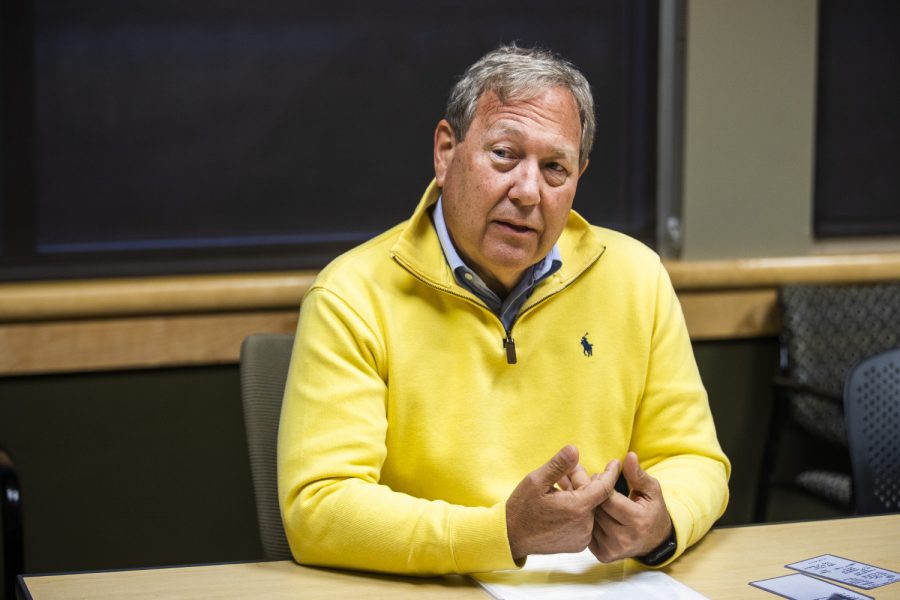Regent President Mike Richards to give spring tuition update at Board of Regents meeting this week
University of Iowa President Bruce Harreld recommended the regents at some point return to steady increases in tuition for resident students after freezing tuition for the fall semester. Regent President Mike Richards is scheduled to give an update on spring tuition on Wednesday.
UI President Bruce Harreld answers questions during an interview with The Daily Iowan in the Adler Journalism Building on Monday, December 9, 2019.
November 15, 2020
Regent President Mike Richards is slated to give an update on the status of Iowa’s three public universities’ tuition for the spring semester at this week’s meeting, according to regent spokesperson Josh Lehman.
His announcement will come after University of Iowa President Bruce Harreld suggested he’s encouraging the state Board of Regents to return the universities under its governance to predictable tuition increases — although the head Hawkeye didn’t specify when.
At a Rotary Club meeting on Nov. 12 Harreld told service member groups that he was urging the Board of Regents — which sets tuition rates — to return to its five-year tuition model in the future after the regents froze tuition for the fall 2020 semester to alleviate student financial burden in the wake of the pandemic. At the time, shared governance leaders expressed concerns about the impact a mid-year tuition increase would have on students’ ability to plan financially.
“One of the things that we’ve now kind of set aside for a little while is our, our long-term tuition plan, but the regents came up with that plan that a few years ago that has a five-year tuition plan, and it created certainty, parents and families and students could understand that we could anticipate those funds,” Harreld said. “It was connected to the funding in the state. And we’ve lost that here a little bit recently with a pandemic. And I really really really am encouraging the state and the Board of Regents to return to that.”
Harreld didn’t specify when he thought the regents should return to the steady increase in tuition.
The multiyear tuition model was created to keep tuition-rate increases consistent. That keeps regent universities competitive with their peer institutions while providing students and families with predictability in planning their finances.
The 2019-20 academic year was the first year of the model, and resident undergraduate students at the UI saw a 3.9 percent tuition increase, while nonresident undergraduates saw a 1 percent increase.
The UI has low tuition rates for resident and nonresident students compared to its peer group universities.
Harreld predicted significant headwinds facing higher education, noting a decline in state appropriations and a looming enrollment cliff stemming from the 2008 financial crisis.
“Other than recruiting more and more students growing market share adding resonance also classrooms, increasing the cost of tuition, and I’d argue, here we go,” Harreld said. “And all is exactly the opposite what we need to do.”
Public-private partnerships
Harreld — who plans to retire once the regents appoint a successor — said he’s urging the university to explore more public-private partnerships with university entities.
After being asked about his future plans for partnerships like the $1.1 billion deal signed between the UI and ENGIE and Meridiam in December 2019 over the university’s utility system, Harreld said the university is exploring additional agreements.
“We’re still exploring [what areas will be in],” he said. “It needs several characteristics. They need some source of revenue, externally. So you can start thinking about where we have revenue sources. You’ve seen P3s across the country in residence halls and dining, in athletics, particularly the NFL. I keep looking at our hospital enterprise and wondering if any of them are possible. All of those are complex.”
Harreld said there is no formal plan to create a new public-private partnership at the UI. He said the university and his cabinet would need more time before discussing and finalizing another partnership.
While discussing the utility system partnership, he said members of his cabinet and himself took a month to understand the complexities of the utility system. Harreld said that is what his cabinet is doing now, as well.
“What we’re now doing is sort of looking for what has these characteristics and we’re taking each area and saying how would it work and could we operate it in a world class way?” Harreld said. “Very importantly, one of the things we put up as a critical component of the utility P3 was we’re not doing this on the backs of our employees. We’re not doing this by downsizing the number of employees. We need to make sure they are well taken care of.”
Harreld said the university is still looking for potential areas for another public-partnership. One of the potential areas the university is exploring is the UI Hawk Shop.
As The Daily Iowan previously reported, the UI is exploring a potential partnership with a private company to manage its Iowa Hawk Shop and University Bookstore as the shops have lost the university hundreds of thousands of dollars in the last five years.
Other Big Ten schools have created a public-private partnership for their bookstores. Harreld did not comment on the UI’s plans during the rotary club meeting.
The UI, however, is not the only university in the state to be considering a P3. As the DI previously reported Iowa State University is currently researching and evaluating its own opportunities for a public-private partnership. The university presented its plan to the Board of Regents in June 2020.
Sarah Watson contributed to this report.






